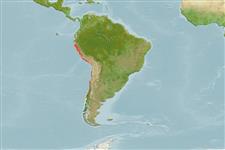Common names from other countries
Classification / Names / Names
आम नाम | उपशब्द | Catalog of Fishes (gen., sp.) | ITIS | CoL | WoRMS
Environment: milieu / climate zone / depth range / distribution range
पारिस्थितिकी
; गहराई सीमा 0 - 500 m (Ref. 356). Tropical, preferred 20°C (Ref. 107945); 5°S - 42°S, 81°W - 70°W (Ref. 106891)
Southeast Pacific: From Paita, Peru to Chiloé, Chile. Tropical to subtropical.
Length at first maturity / आकार / वज़न / Age
Maturity: Lm ? range ? - ? cm Max length : 12.0 cm ShL पुल्लिंग / अलिंग; (Ref. 356)
Life cycle and mating behavior
परिपक्व अवधि | पुनरुत्पत्ति | मछलीऔ का अंडे देना | अंडे | Fecundity | लार्वा
Life cycle: Embryos develop into free-swimming trocophore larvae, succeeded by the bivalve veliger, resembling a miniature clam (Ref. 833). Spawning occurs year-round but mainly during spring and autumn (Ref. 106788).
SAUP Database. 2006. (Ref. 356)
IUCN Red List Status (Ref. 130435: Version 2024-1)
CITES status (Ref. 108899)
Not Evaluated
Not Evaluated
Human uses
मात्स्यिकी: व्यापारिक; जलीयकृषि: व्यापारिक
FAO - जलीयकृषि: production; मात्स्यिकी: landings | FishSource | Sea Around Us
साधन
इंटरनेट स्रोत
Estimates based on models
लौटाव
ऊंचा, न्यूनतम जनसंख्या दुगनी समय अवलागत 15 महीने। (K=1.99-2.88).
Vulnerability
Low vulnerability (19 of 100).
